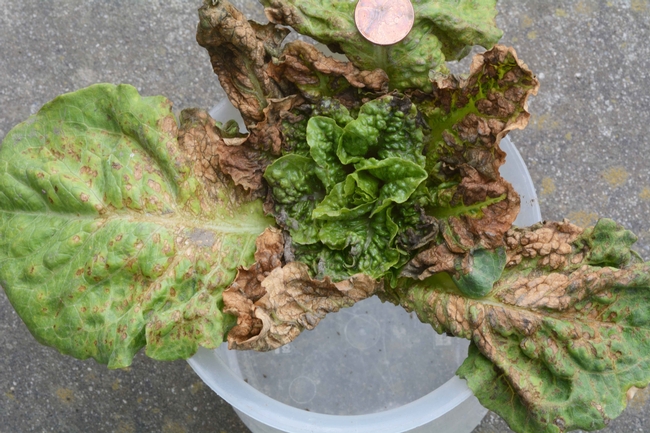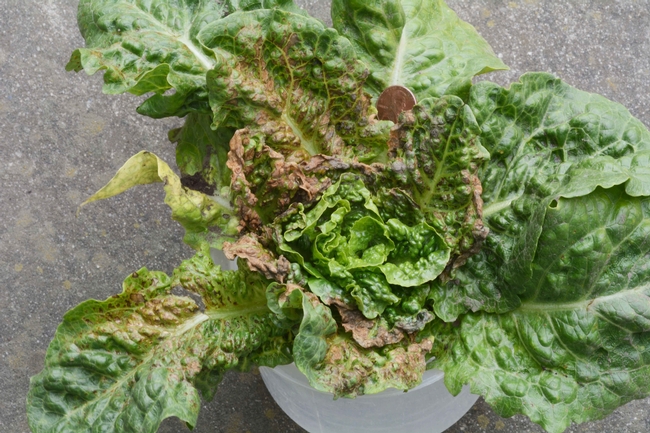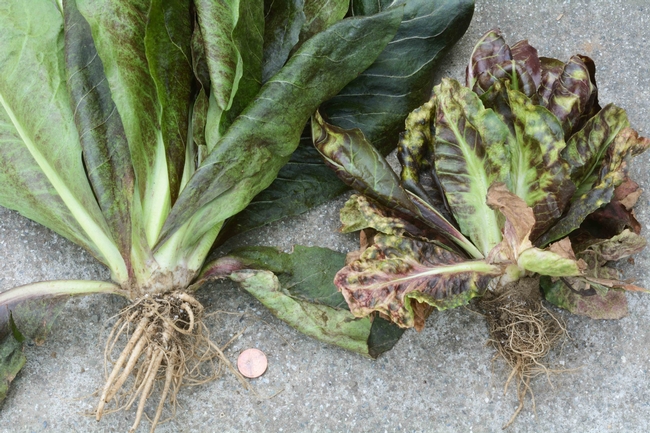As early as March 2015, leafy green crops in the Salinas Valley exhibited symptoms indicative of virus diseases. In fact, viruses in the tospovirus group have been confirmed in a number of fields in the Valley:
1. Impatiens necrotic spot virus (INSV) on lettuce. Diseased leaves have tan, brown, or blackish spots and dead sections; this necrotic tissue can resemble damage caused by pesticide or fertilizer applications (see photos 1 and 2 below). Some leaf yellowing can also be observed. Symptoms can be found on both the older, outer leaves as well as on the newer leaves near the center of the plant growing point. If plants are affected early in their development, growth can be stunted. A number of fields have been confirmed to be positive for INSV, though in each case disease incidence was low (well below 1%).
2. Tomato spotted wilt virus (TSWV) on radicchio. Diseased leaves have yellow spots, streaks, mottles, and other symptoms (see photos 3 and 4 below). Brown necrotic leaf spots are sometimes present. If radicchio is infected when young, the plants are severely stunted, leaves are deformed and twisted, and head-forming cultivars fail to develop normal heads. Disease incidence was moderately high.
The INSV and TSWV pathogens are spread by thrips. In our coastal region, these tospoviruses are spread only by the western flower thrips (Frankliniella occidentalis). In the early part of 2015, growers and PCAs reported moderate to high thrips pressure already. This abundance of the vector certainly accounts for these early outbreaks of tospovirus disease. A number of weeds and other hosts serve as reservoirs of the viruses. Immature thrips feed on these infected plants, develop into adults, and can then spread INSV and/or TSWV to lettuce and other surrounding host crops. The dry spring is contributing to early drying up and senescing of weeds and hillside vegetation; this early decline of surrounding vegetation could be driving thrips populations into fields earlier than normal. Radicchio and all lettuce types (iceberg, romaine, greenleaf, redleaf, butter) are susceptible to both TSWV and INSV, so field personnel should be aware of this early development.
Plants suspected of being infected with tospoviruses can be sent for analysis to the UC Cooperative Extension diagnostic laboratory in Salinas.
Photo 1. Lettuce infected with Impatiens necrotic spot virus.
Photo 2. Lettuce infected with Impatiens necrotic spot virus.
Photo 3. Radicchio plant on right infected with Tomato spotted wilt virus.
Photo 4. Radicchio leaves on right infected with Tomato spotted wilt virus.



